Diphenylhydrazine is a man-made chemical that occurs in two
isomeric forms: 1,1-diphenylhydrazine and 1,2-diphenylhdrazine.
Diphenylhydrazine is produced by the reduction of
nitrobenzene. Little or no information is available for
1,1-diphenylhydrazine. Most toxicological and use data pertain
to 1,2-diphenylhydrazine.
Previously, 1,2-diphenylhydrazine was used for producing
benzidine that was used in the synthesis of benzidine-based
dyes. However, these dyes are no longer produced in the United
States. The primary use of 1,2-diphenylhydrazine is in the
production of the anti-inflammatory agent phenylbutazone
and sulfinpyrazone, a uricosuric agent.
Yellow crystals. Insoluble in water.
Toxic gases may be formed by mixing 1,1-DIPHENYLHYDRAZINE with acids, aldehydes, amides, carbamates, cyanides, inorganic fluorides, halogenated organics, isocyanates, ketones, metals, nitrides, peroxides, phenols, epoxides, acyl halides, and strong oxidizing or reducing agents. Flammable gases are formed by mixing materials in this group with alkali metals. Explosive combination can occur with strong oxidizing agents, metal salts, peroxides, and sulfides.
Definitive information regarding the environmental fate and
behavior of diphenylhydrazine in environmental media is
extremely limited. No information is available affirming persistence
of diphenylhydrazine in the environment or definitive
pathways for its degradation. The low vapor pressure of diphenylhydrazine
precludes it being a significant air contaminant.
Diphenylhydrazine may be moderately absorbed into soil but it
would be quickly oxidized to azobenzene. The half-life of
diphenylhydrazine in water is reportedly less than 15 min and is
likely due to its oxidation to azobenzene and benzidine.
Purify it via the hydrochloride [530-47-2], which has m 165-170o(dec) after crystallization from aqueous EtOH (+ a few drops of HCl) and recover the free base with aqueous NaOH, extract it into Et2O, dry it (KOH), filter, evaporate and distil the residue under a vacuum. The distillate crystallises on cooling. The benzoyl derivative has m 194o (from Me2CO), and the 4-nitrophenyl hydrazone (with the aldehyde) has m 131-132o. [Koga & Anselme J Org Chem 33 3963 1968, Beilstein 15 IV 55.]
The mechanism of action of diphenylhydrazine is not known.
It is possible that some toxic effects may be attributed to its
major metabolites, aniline and azobenzene, both of which are
known carcinogens. Results of metabolism studies reporting
aniline, benzidine, hyroxybenzidines, and aminophenols as
metabolites in rats following multiple routes of administration
suggest that the diphenylhydrazine metabolism may be similar
to that of azobenzene and aniline. It is also possible that
conversion of 1,2-diphenylhydrazine to aniline in the gastrointestinal
tract may occur due to intestinal microflora and via
acid hydrolysis.
